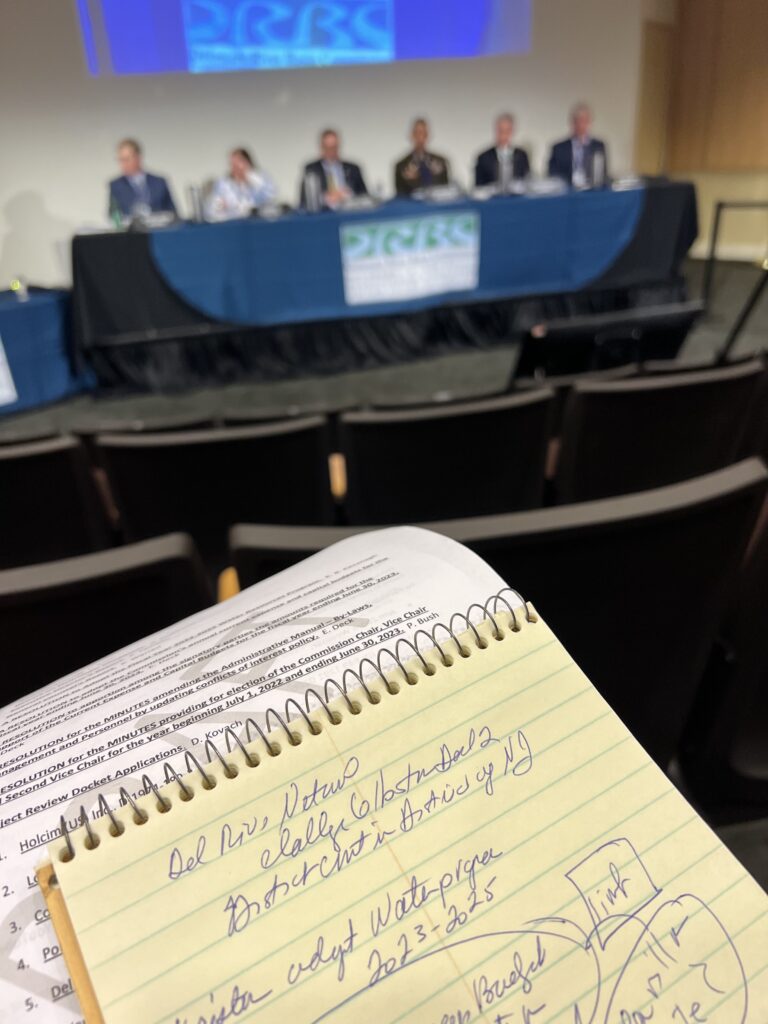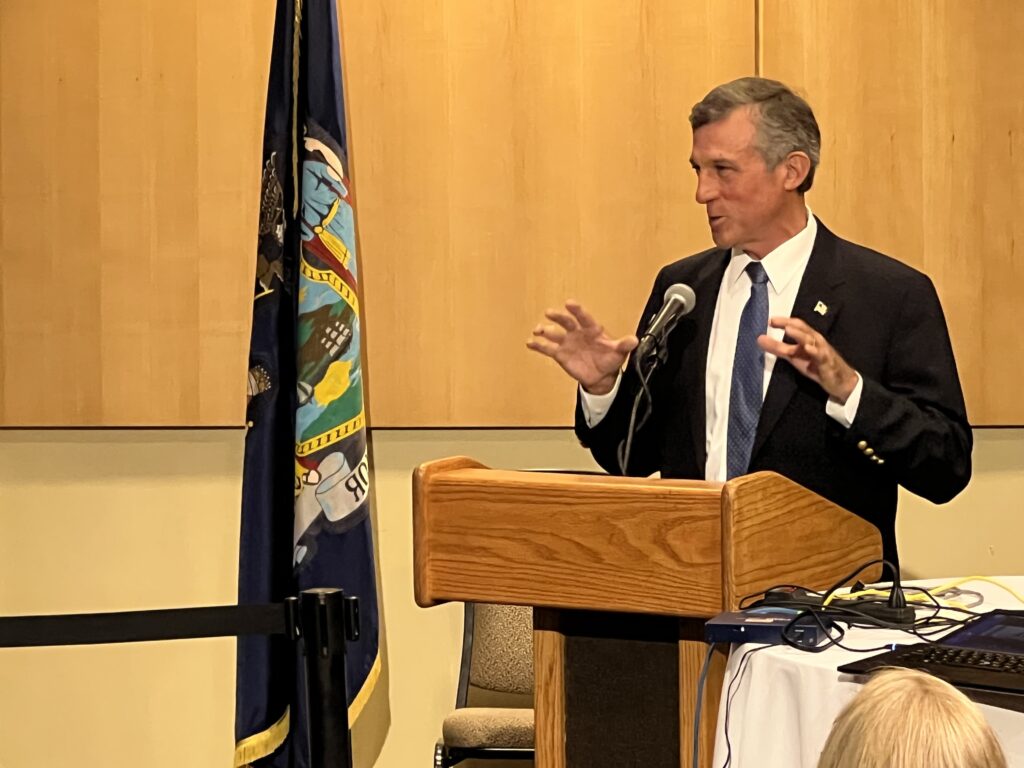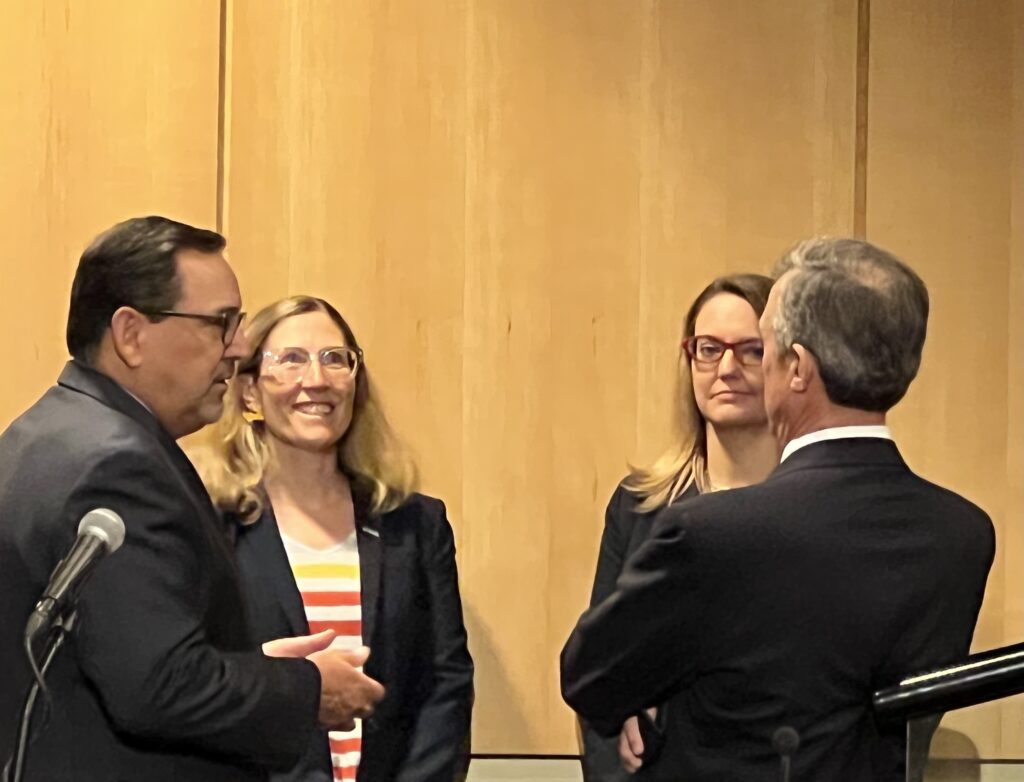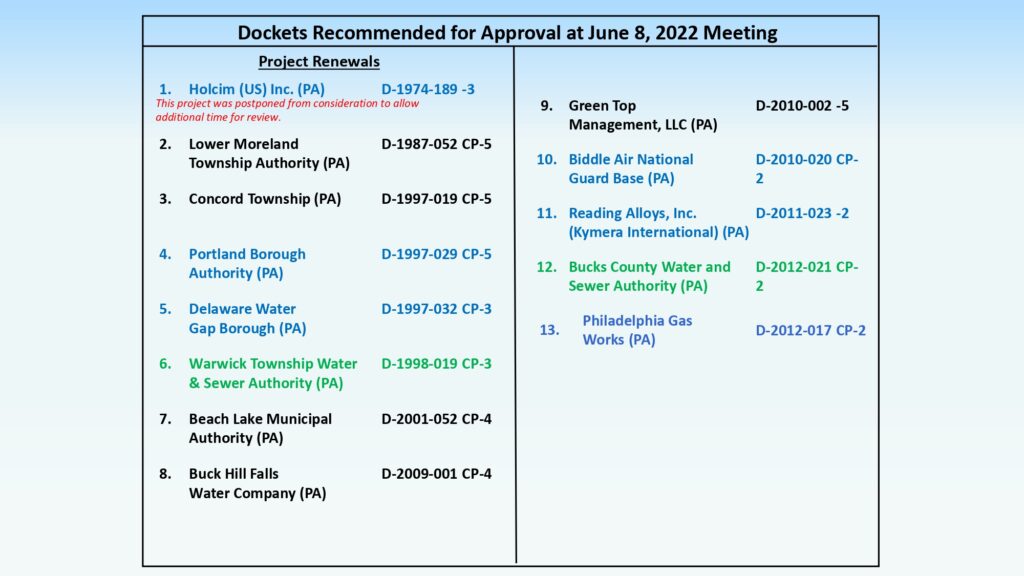
Reporter’s notebook: What goes on at a DRBC meeting
| June 27, 2022
“So, what is the DRBC all about?” Delaware Gov. John Carney asked in his welcoming address to this, the first in-person meeting of the Delaware River Basin Commission in more than two years, which happened at the Chase Center in Wilmington, Del., on June 8.

He was recalling his first contact with the DRBC back in the early days of his career working in local government.
Now he knows ALL about the DRBC — his state is the only state with a long history of living up to its promised financial support of the commission.
But I’ve heard that question – “So, what is the DRBC all about?” — from many people in the watershed.
Deep reading of Delaware Currents will fix that, of course, (she said), but another way to get to know it is to attend one of its meetings.
So, let’s do that.

The first thing you see as you enter the Chase Center in Wilmington, Del., is a trio of protestors. Protestors with various missions are a common sight. The most constant is the Delaware Riverkeeper Network. Tracy Carluccio, one of them, is the deputy director of the network and said, “You (Delaware Currents) and me are the only regulars wherever the meeting is!”
True enough. These meetings with representatives of the four states and the federal government in attendance meet four times a year to vote on resolutions that can be as little as approving the minutes of the previous meeting or as large as the fracking ban the DRBC approved in February 2021.

The meetings are highly scripted. Most often, there are no surprises. The staff of the DRBC work to create the resolutions that the commissioners vote on, and work to make sure that — from my perspective — those resolutions are well thought-out and meet the political needs of the four state governors (New York, New Jersey, Pennsylvania, and Delaware) who are the actual members, even though the governors are seldom in attendance.
Even today, with Carney’s appearance, he wasn’t staying for the meeting but left his representative — Shawn Garvin, Delaware’s secretary of the Department of Natural Resources and Environmental Control — to vote on his behalf. Garvin is the highest-ranking gubernatorial representative who regularly attends these meetings.
There is security at these meetings and a metal detector. Understandable because passions can run high.
And there are rules about the sorts of protest regalia that are allowed in the meeting hall — no large placards, for example. The Riverkeeper Network is very imaginative about finding ways to circumvent the rules. For example, to protest the PennEast pipeline, which has since been shelved, adherents wore green headbands that said “No PennEast.”
Once, in February 2016, a meeting coincided with Valentine’s Day, so the network brought a huge Valentine’s card with tons of signatures asking that the DRBC show its “love” for the river by actions related to the now-defunct PennEast pipeline. And more: There were bouquets!!
Steve Tambini, the executive director of the DRBC, thanked them for the gift but said the DRBC couldn’t keep them and suggested they could be given to a nearby nursing home. See what I mean about strictly scripted? It’s really only in the various protests that some manage to color outside the lines.

It should be noted that the DRBC attracts a lot of these protestors on important issues because there aren’t a lot of other avenues for public input. Although the DRBC can be slow in its work and tightly scripted when it meets in public, its work is transparent and its advisory committees, which are open to the public, are where the work is done with committee members from all areas of interest in the watershed.
Maya van Rossum, the Delaware Riverkeeper, is on one of those — the Water Quality Advisory Committee — as is a representative of Chemours. Even Tambini has said that the committee is where the sausage is made!
A regular part of the full-commission meeting is a hydrologic report, often given as it was here, by Amy Shallcross, the DRBC’s manager for water resource operations.

It’s by listening — and watching — these reports that I began to understand the complicated nature of weather in our watershed. Today, Shallcross showed maps of the watershed that showed the top (New York) and bottom (the bay and New Jersey) were on the dry side, while the middle was near normal.
Although we are one basin, we sure don’t have similar weather, which explains why some areas can get flooded while others remain dry.

No drought is anticipated in our region but above-average temperatures and rainfall are expected.
The whole hydrology report, including a three-month forecast, is here. You can check hydrologic conditions in the basin daily at hydrosnap.drbc.net.
Then Ken Warren, DRBC’s legal counsel, offered an update about cases involving the DRBC. These days, they are mostly cases about the DRBC’s fracking ban and one the Delaware Riverkeeper filed about the DRBC’s approval of a dock in Gibbstown, N.J. Delaware Currents has done a slew of stories about that, a project that would transport LNG by train or truck from Wyalusing, Pa., to Gibbstown, N.J.
Then the executive director’s report. For that, as for much else that happened at this meeting, you can visit https://www.nj.gov/drbc/meetings/archive/recent-drbc-mtg.html.
There were two significant resolutions, one is the DRBC budget. The other was the resolution to confirm the signatory parties financial “promise” of support. Read more here.
The meat of most meetings are the dockets – that’s DRBC-speak for the projects up for review by the commission: water withdrawals and wastewater discharge from all over the watershed.
In the regulatory role given to the DRBC by the interstate compact, the DRBC is required to review and consider water withdrawals over certain thresholds. Here is its wording:
“The Commission also regulates the discharge of pollutants into the ground or surface waters of the Delaware River Basin. Discharges over 50,000 gpd during any consecutive 30-day period require the DRBC’s approval, be it from wastewater treatment facilities or the importation or exportation of wastewater. DRBC approval of wastewater projects is contingent upon the determination that the discharge meets treatment standards and does not adversely affect established water quality criteria for the Basin’s waters.” Again, stricter rules apply for the Southeastern Pennsylvania Groundwater Protected Area (GWPA.)
Here’s today’s lineup:

The investigation of those dockets is overseen by David Kovach, the DRBC’s manager for project review. Almost all dockets are approved. Occasionally as today, one is “held back” for further investigation – that’s the first one “Holcim (US) Inc. (PA).” It looks to be its cement plant in Whitehall, Pa.

The difference in type of meeting matters to the DRBC. When you comment at a public hearing session, those comments are on the record. After business meetings, like this one, there is a public comment period but it’s not “official.”
At this meeting, as at most meetings, the comments were from a host of advocacy groups, most of them members of the Frack Ban Coalition. Today their comments focused on the DRBC’s upcoming ruling on the import and export of water to/from the basin. Story here.
We heard from the Delaware Riverkeeper Network, Delaware’s League of Women Voters, Damascus Citizens for Sustainability, the National Resources Defense Council, Food and Water Watch, Environment New Jersey, Clean Water Action and Earthworks — just a smattering of the advocacy organizations that keep an eye on what’s going on.






